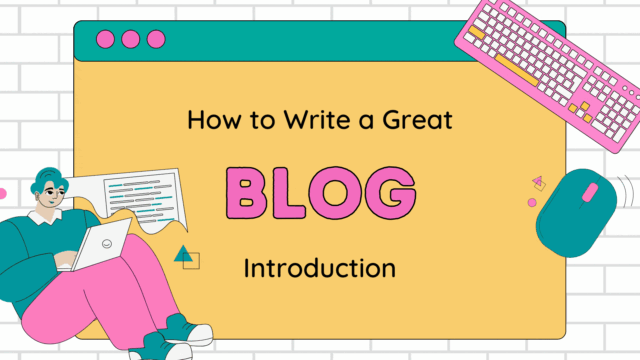When it comes to blogging, the introduction of your post is your chance to make a first impression that sticks. It’s the handshake, the smile, and the first few words that determine whether a reader will dive into your content or move on.
Crafting a great blog introduction is an art form, one that involves engaging your audience immediately, establishing your credibility, and setting the stage for the insightful content to follow.
In this article on how to write a blog introduction, we’ll explore how to write an introduction that captivates your readers from the get-go and ensures they stay for the entire journey.
Key Takeaways
- Begin with a hook to immediately engage the reader and make them want to continue reading your blog post.
- Clearly outline the blog’s purpose, relevance, and what readers can expect, including the famous five W’s (Who, What, When, Where, Why).
- Use storytelling and personal anecdotes to create a connection with your audience and give your blog a unique voice.
- Establish trust and credibility early on by highlighting your expertise and experience relevant to the blog’s niche.
- Ensure your introduction is well-structured with descriptive subheadings and a visually appealing format to enhance readability and anticipation.
Crafting a Captivating Opening

The Art of the Hook: Engaging Your Audience from the First Sentence
The first few sentences of your blog post can make or break the reader’s interest. Start with a hook that immediately grabs attention; this could be a surprising fact, a provocative question, or a bold statement. Ensure that your opening is a gateway to the main message of your article, setting the tone for what’s to come.
- Share a statistic or a fact
- Pose a rhetorical question
- State a controversial opinion
Your introduction is a promise to the reader about the value you’re about to deliver. It should spark curiosity and offer a glimpse into the journey you’re inviting them on.
Remember, the goal is to get people excited to read more. A well-crafted hook not only piques interest but also sets expectations for the rest of your post. Keep it concise, compelling, and relevant to the theme of your content to ensure that your readers are eager to continue.
Setting the Stage: Introducing Your Blog’s Purpose and Relevance
When launching your blog, it’s crucial to clearly articulate its purpose and relevance to your audience. This not only helps set expectations but also establishes a connection with your readers from the outset.
Consider addressing the ‘Five W’s’ in your introduction:
- Who: Share a bit about yourself, highlighting any credentials or experience that lend authority to your blog.
- What: Outline the topics you’ll explore, giving readers a taste of the content they can anticipate.
- When: Inform your audience of your posting schedule, so they know when to look for new insights.
- Where: Mention other platforms where your content is available, like social media, to broaden your reach.
- Why: Inspire your readers by sharing the passion or unique perspective that drove you to start the blog.
By presenting something remarkable, you not only capture attention but also convey the inherent value your blog post brings. This anticipatory revelation promises an enriching and eye-opening exploration ahead.
Remember, the introduction is your chance to make a first impression. Use it to build trust by being transparent about your intentions and what readers can gain from following your blog. An introductory post that covers these elements can take the pressure off and serve as a solid foundation for all future content.
The Power of Storytelling: Sharing Personal Anecdotes to Build Connection

Storytelling is a powerful tool in the arsenal of any blogger. It’s the personal anecdotes that transform a post from a mere collection of words into a relatable narrative. By presenting something remarkable, you not only capture attention but also convey the inherent value your blog post brings.
Create an enjoyable reading experience that encourages them to stay engaged. Offer your readers a taste of the extraordinary by unveiling a fascinating fact or a compelling result early on.
When you share a piece of your life, you’re not just telling a story; you’re inviting the reader into your world. Here are a few ways to effectively use storytelling in your blog introduction:
- Relate a relevant personal experience that connects with the central theme of your post.
- Highlight a challenge you’ve faced and how it relates to the topic at hand.
- Share an unexpected outcome or lesson learned that piqued your interest in the subject matter.
Remember, the goal is to build a bridge between you and your readers. Whether it’s a brief mention of your expertise, a transparent acknowledgment of shared experiences, or a relatable anecdote, instill confidence in your readers. Demonstrating authenticity and transparency from the start fosters trust, making your audience more receptive to the insights you’re about to share.
Structuring Your Introduction for Maximum Impact

The Five W’s: Laying Out the Who, What, When, Where, and Why
When crafting your blog introduction, addressing the Five W’s is crucial for setting clear expectations for your readers. This framework helps you outline the essential information about your blog and its content.
- Who: Define who you are as the author, your expertise, and what perspective you bring to the table.
- What: Describe the topics your blog will explore and the value it aims to provide.
- When: Share the frequency of your posts to set a consistent expectation for your audience.
- Where: Mention the platform or channels where your readers can engage with your content.
- Why: Articulate the purpose of your blog and what inspired you to start this journey.
By methodically answering these questions, you not only establish a foundation for your blog but also build a roadmap for your content strategy. This approach ensures that your introduction aligns with your blog’s overall mission and sets the stage for the posts to come.
Balancing Information with Intrigue: How Much to Reveal Upfront
When crafting your blog introduction, it’s crucial to strike a balance between providing information and maintaining intrigue. Your goal is to give enough context to inform the reader, yet not so much that you extinguish their curiosity. Start with a broad overview and then zoom in on the specifics as you progress.
- Spark curiosity by asking a question or hinting at a surprising fact.
- Be specific to set clear expectations without revealing all the details.
Remember, the aim is to ignite curiosity and leave your reader eager to uncover the story unfolding.
By presenting something remarkable, you capture attention and convey value, promising an enriching exploration ahead. However, avoid overloading the introduction with too many details; keep the most relevant and interesting facts for the body of your post. This approach not only establishes trust but also sets the stage for a reader-writer relationship built on authenticity and transparency.
Pros and Cons: Deciding if Your First Post Should Be an Introduction
When launching a blog, the decision of whether to begin with an introductory post or to dive right into content can be pivotal. An introductory post can ease you into the blogging world, setting a clear tone and giving readers a sense of who you are. However, it might not stand the test of time as your blog grows.
Conversely, starting with a content-rich post can establish your expertise immediately, potentially improving long-term keyword rankings. Yet, it may necessitate an additional ‘About Me’ page and could delay your blog’s launch as you strive for a perfect first impression.
Weighing the pros and cons is essential, as your choice will shape your blog’s initial trajectory and reader engagement.
Here’s a quick rundown of the advantages and disadvantages:
- Pros of an Introductory Post:
- Sets the tone for your blog
- Introduces you to your readers
- Lowers the pressure for your first post
- Quick to launch
- Cons of an Introductory Post:
- Risk of being overshadowed by future content
- Possible redundancy with an ‘About Me’ page
Your niche plays a crucial role in this decision. For instance, travel bloggers might benefit from an introduction, sharing their unique perspective, while food bloggers might prefer to showcase their expertise with a standout recipe.
The First Impression: Establishing Credibility and Trust

Highlighting Your Expertise and Experience
When crafting the introduction to your blog, it’s crucial to instill confidence in your readers by showcasing your expertise and experience. This not only establishes your authority but also sets the stage for the value you’re about to deliver.
- Relevant Credentials: Mention any certifications, degrees, or accolades that relate to your blog’s topic.
- Shared Experiences: Relate to your audience by acknowledging common challenges or successes.
- Authenticity: Be transparent about your journey and what you bring to the table.
By presenting something remarkable, you not only capture attention but also convey the inherent value your blog post brings.
Remember, building trust is fundamental to a lasting reader-writer relationship. Your introduction is the perfect opportunity to communicate your value and establish your credibility and reliability.
Building a Relationship with Your Readers from the Get-Go
Building a strong relationship with your readers starts with the very first words of your blog post. Make it relatable by addressing your audience directly, using ‘you’ and ‘your’ to create a sense of personal connection. Ask questions to engage them and make them feel like part of a conversation.
By presenting something remarkable or an amazing fact, you set the stage for an enriching experience that keeps the reader hooked.
Establishing trust is crucial, and it can be done by sharing your expertise or relevant credentials. Be transparent and authentic, as this fosters a deeper connection and makes your audience more receptive to your message.
Here are some steps to consider when writing your introduction:
- Address your readers from sentence one.
- Launch by describing an emotion or presenting a fascinating fact.
- Identify your readers’ problem and offer a glimpse of the solution.
- Play off their hopes and aspirations related to the topic.
- State an amazing fact or result that the blog post can bring to them.
- Ask a question to invite engagement and start a conversation.
Choosing the Right Approach for Your Niche
Understanding your niche is crucial to determining the right approach for your blog’s introduction. Your niche influences whether an introduction is necessary and how to best connect with your audience. For instance, travel bloggers often benefit from an introductory post to share their unique perspectives, while food bloggers might prefer to jump straight into sharing recipes.
Consider these questions to guide your approach:
- What is my niche?
- Will I have an “About Me” page?
- Do I aim for search engine visibility?
Your answers will shape the tone and structure of your introduction, ensuring it aligns with your blog’s goals.
Remember, the introduction sets the tone for your blog. It’s where you can showcase your passion and problem-solving skills, making your content not just informative but also engaging. Choose a strategy that reflects your style, meets your business objectives, and resonates with your intended audience.
The Role of Subheadings and Formatting in Introductions

Organizing Your Thoughts with Descriptive Subheadings
When you break up your content into sections using descriptive subheadings, you’re not just organizing your thoughts; you’re also guiding your readers through your narrative. This methodical approach allows for a clearer understanding of your blog’s structure and main points.
- Introduction: Set the stage for your post.
- Subheadings: Clearly define each section.
- Paragraphs: Focus on one main idea each.
- Bullet points or lists: Present information cleanly.
Remember, subheadings serve as signposts for your readers, making it easier for readers to scan the post. They should be informative yet concise, providing a snapshot of what to expect in each section. Crafting subheadings that are both descriptive and engaging can significantly enhance the readability and appeal of your blog.
By effectively using subheadings, you ensure that your readers can quickly find the information they’re looking for, which is essential in retaining their attention and interest.
The Importance of Visual Appeal and Readability
The visual appeal of your blog plays a crucial role in keeping readers engaged. A well-designed introduction sets the tone for the entire post, ensuring that readers are more likely to stay and read on. To enhance visual appeal and readability:
- Use varied typography: Different fonts and styles can signal the start of your introduction and emphasize key points.
- Incorporate whitespace: Generous spacing between lines and paragraphs prevents visual fatigue and makes your content more approachable.
- Employ lists and bullet points: These help break up text and present information in an easily digestible format.
Remember, the goal is to create an inviting text layout that guides the reader naturally from one point to the next, without overwhelming them with dense paragraphs.
By paying attention to these elements, you can make your blog not just a source of information, but a pleasure to read. The impact of design on blog readability is significant; incorporating relevant and high-quality elements that complement the content can make the blog more visually appealing and engaging for readers.
Creating Anticipation with a Well-Formatted Intro
The anticipation of your readers hinges not just on what you say, but also on how you present it. A well-formatted introduction sets the stage for an engaging read, guiding your audience through the opening with ease and style. Consider the visual appeal of your intro; a different font or bolded words can signal the start of something important, making your readers immediately aware they’re embarking on an insightful journey.
- Use descriptive subheadings to break up text
- Employ bullet points to highlight key takeaways
- Bold or italicize to emphasize crucial points
By presenting something remarkable in a well-structured manner, you not only capture attention but also convey the inherent value your blog post brings, promising an enriching and eye-opening exploration ahead.
Remember, the goal is to create a seamless experience that compels the reader to continue. Balancing information with intrigue is crucial; reveal enough to pique interest but leave them wanting more. Your introduction is the gateway to your content; make it inviting, make it promising, and most importantly, make it unforgettable.
Expert Tips for a Memorable Blog Introduction

Crafting a Hook That Resonates with Your Audience
To craft a hook that resonates with your audience, start by understanding their needs, preferences, and pain points. This insight allows you to tailor your introduction in a way that captures their interest and addresses their concerns from the very beginning.
A hook can be a provocative question, a startling fact, or a bold statement that piques curiosity. It should be concise, compelling, and lead smoothly into the core message of your post.
Remember, the goal is to entice readers to continue on, not to give away everything upfront. Here are some techniques to consider:
- State a controversial opinion or ask a rhetorical question.
- Share a surprising statistic or fact.
- Present a problem that your blog post will solve.
By immediately presenting a scenario that is relevant to the theme of your content, you create a snapshot that sparks interest and sets the tone for the rest of your article.
Introducing the Core Message of Your Post
Understanding how to write a blog introduction that effectively presents the core message of your post is crucial. The introduction is not just a gateway to your content; it’s a strategic component that sets the tone and expectations for your readers.
The core message should be clear and concise, ensuring that readers grasp the essence of your post from the outset.
Here are a few steps to help you introduce the core message:
- Start with a hook that piques interest and relates directly to the main topic.
- Clearly state the core message early on, ideally within the first few sentences.
- Use your focus keyphrase in the introduction to align with your audience’s search intent.
- Establish trust by showcasing your credibility and the value your post will bring.
Remember, the introduction is your chance to make a strong first impression. It should answer the reader’s initial questions and build anticipation for the insights to follow.
Ensuring a Smooth Transition to the Main Content
A smooth transition from your introduction to the main content is crucial for maintaining reader engagement. Ensure your introduction flows naturally into the body of your post by using transitional words and phrases that guide your readers. This technique not only enhances readability but also prepares your audience for the detailed content that follows.
When considering how to write a content brief, it’s important to include transitional elements that will lead into the main sections of your blog. Here’s a simple list to help you remember key points:
- Recap the main points of your introduction briefly.
- Use transitional phrases to signal a shift in focus.
- Preview the upcoming content without giving away too much.
Remember, the goal is to create a bridge between your introduction and the main content that entices readers to continue on the journey with you.
By carefully crafting this transition, you set the stage for a cohesive and compelling narrative that resonates with your audience.
Conclusion
Crafting an engaging introduction for your blog post is essential for capturing your audience’s attention and setting the stage for the valuable content to follow. By incorporating the strategies discussed, such as starting with a hook, clearly stating the purpose of your post, and establishing trust, you can create a compelling opening that resonates with readers. Remember, the introduction is your first impression—make it count. Whether you’re a seasoned blogger or just starting, these tips will help you write introductions that not only draw readers in but also encourage them to stay for the entire journey. Keep experimenting with different techniques to find what works best for your unique voice and audience. Happy blogging!
Frequently Asked Questions
What are some effective strategies for writing a great blog introduction?
Effective strategies include starting with a compelling hook, clearly stating the purpose and relevance of your blog, using personal anecdotes to connect with readers, and addressing the five W’s (Who, What, When, Where, and Why) to set expectations.
How can I engage my audience from the first sentence of my blog post?
Engage your audience by presenting a provocative question, a surprising fact, a relatable anecdote, or a bold statement that piques curiosity and encourages them to read on.
Should my first blog post be an introduction, and what are the pros and cons?
An introductory first post can set the tone and establish who you are, but it may get buried over time. Alternatively, an ‘About Me’ page can serve the same purpose without the risk of being overlooked as new content is added.
How important is formatting and subheading use in a blog introduction?
Formatting and subheadings are crucial for organizing thoughts, enhancing visual appeal, and improving readability, which helps to maintain reader interest and anticipation.
How can I establish credibility and trust with my readers in my blog’s introduction?
Establish credibility by highlighting your expertise and experience, and build trust by being relatable and transparent about your intentions and the value you aim to provide through your blog.
What approach should I take in my introduction if I’m in a niche like food or travel?
Your approach depends on your niche. In travel, an introductory post helps readers get to know you, while in food, diving right into great content like a unique recipe can showcase your expertise immediately.












